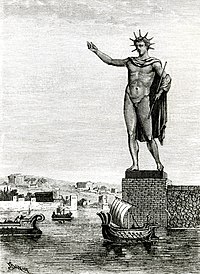Chares of Lindos
Chares of Lindos | |
|---|---|
 The Colossus of Rhodes, built by Chares of Lindos | |
| Born | before 305 BC |
| Died | c. 280 BC Rhodes, Greece |
| Occupation | sculptor |
| Years active | ?-c.280 BC |
Notable work | Colossus of Rhodes |
Chares of Lindos (/ˈkɛəriːz/; Greek: Χάρης ὁ Λίνδιος, gen.: Χάρητος; before 305 BC-c. 280 BC) was a Greek sculptor born on the island of Rhodes. He was a pupil of Lysippos.[1] Chares constructed the Colossus of Rhodes in 282 BC, an enormous bronze statue of the sun god Helios and the patron god of Rhodes.[2] The statue was built to commemorate Rhodes' victory over the invading Macedonians in 305 BC, led by Demetrius I, son of Antigonus, a general under Alexander the Great. Also attributed to Chares was a colossal head which was brought to Rome and dedicated by P. Lentulus Spinther on the Capitoline Hill, in 57 BC (Pliny, Natural History XXXIV.18).[3]
The Colossus of Rhodes is one of the Seven Wonders of the Ancient World,[4] and was considered Chares's greatest accomplishment, until its destruction in an earthquake in 226 BC.[5]
It is believed that Chares did not live to see his project finished. There are several legends stating that he committed suicide. In one tale he had almost finished the statue when someone pointed out a small flaw in the construction. The sculptor was so ashamed of it he killed himself.[citation needed] In another version, the Rhodians asked Chares how much he would charge for a statue fifty feet high, and when he answered, asked him how much for a statue twice as big; he answered twice as much – and they awarded the contract; he had overlooked that doubling the height would mean an eightfold increase in the amount of materials needed. This drove him to bankruptcy and eventually suicide.[6] The work may have been completed by Laches, also an inhabitant of Lindos.[7][8]
In popular culture[]
- L. Sprague de Camp's novel The Bronze God of Rhodes is written as Chares' memoirs of the Siege of Rhodes and the building of the Colossus of Rhodes.
- Asteroid 236746 Chareslindos, discovered by Vincenzo Casulli in 2007, was named after the ancient Greek sculptor.[9] The official naming citation was published by the Minor Planet Center on 4 November 2017 (M.P.C. 107121).[10]
References[]
- ^ Van Gelder, Lawrence (10 August 2006). "Arts, Briefly". The New York Times. Retrieved 19 December 2007.
- ^ "Information about the Colossus of Rhodes". rhodos-travel.com. Retrieved 19 December 2007.
- ^ "The Ancient Library". ancientlibrary.com. Archived from the original on 21 May 2008. Retrieved 16 May 2008.
- ^ "The Colossus of Rhodes". unmuseum.org. Archived from the original on 8 April 2011. Retrieved 19 December 2007.
- ^ "Colossus of Rhodes". corrosion-doctors.org. Retrieved 19 December 2007.
- ^ Sextus Empiricus, Against the Logicians 1.107-8; a much later work by a philosopher, not a historian.
- ^ "A dictionary of Greek and Roman biography and mythology (ed. William Smith)". perseus.tufts.edu. Retrieved 16 May 2008.
- ^ "A general and bibliographical dictionary of the fine arts". books.google.se. Retrieved 16 May 2008.
- ^ "236746 Chareslindos (2007 LP)". Minor Planet Center. Retrieved 1 September 2019.
- ^ "MPC/MPO/MPS Archive". Minor Planet Center. Retrieved 1 September 2019.
External links[]
. Encyclopædia Britannica. 5 (11th ed.). 1911.
- Hellenistic sculptors
- Ancient Rhodian sculptors
- 3rd-century BC Greek people
- 3rd-century BC Greek sculptors